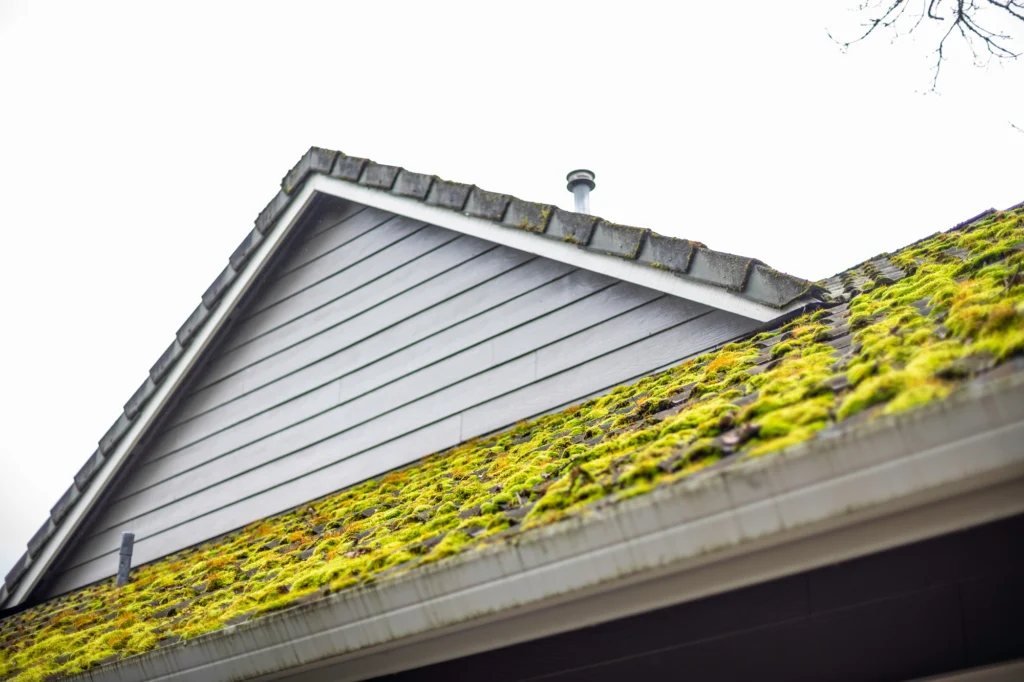If you imagine a quaint cottage in a fairy tale, you might visualize lots of greenery, including a mossy roof. While moss on the roof might seem cozy and romantic in picture books, it’s not something you’ll appreciate if it grows on your own roof.
Moss growth is common, particularly in damp or shaded areas. It can’t be left unchecked; if you don’t remove it, it can cause roof shingles to weaken and even rot over time.
Removing moss on your own is possible, but hiring a professional to do it for you is usually safer, more effective, and more convenient. Either way, keeping your home protected from moisture-related issues, including a mossy roof, is essential.
In this guide, we’ll explain how to identify moss on your roof, what can cause moss to grow on your roof, why you need to remove it, and the best way to tackle the job. Read on for our best advice and tips when it comes to cleaning moss off of your roof.
In this article:
- Do You Have Moss on Your Roof?
- Why Moss Accumulates on a Roof
- Why Moss Removal Matters
- How to Clean Moss Off a Roof
- Final Thoughts
- Frequently Asked Questions
Do You Have Moss on Your Roof?

In some cases, moss on the roof can look like clumps of green thread hanging down from your roofline. Other times, though, the signs can be a bit less obvious. If you notice any of these issues with your roof, you might be dealing with moss and should address the situation promptly:
- Visible green patches: The most visible sign will be fuzzy green patches on the shingles. You will likely notice them on the shaded areas of your roof; if you have one side that’s often shaded by trees or doesn’t get much sunlight, that’s usually where moss growth will start.
- Lifting shingles: Moss can grow under your shingles, which makes them less obvious when you look from the ground. However, when this happens, it usually causes the shingles to lift or curl. Sometimes, the shingles even become loose and fall off.
- Wetness on the roof: If you don’t see any green patches but notice a lot of dampness, it could be a very thin layer of moss holding onto moisture. This can be an early sign of moss, so it’s wise to take a closer look.
- Leaves on the roof: While moss wouldn’t cause leaves to accumulate on your roof, those piles of leaves and other debris, such as sticks, can be causing and hiding moss. Particularly in the fall, after most of the leaves have fallen, it’s a good idea to use either a leaf blower or a broom to remove debris from the roof so it doesn’t encourage (or hide) moss.
Moss isn’t the only vegetation you might get on your roof. Algae, mold, and mildew are also possible. They can have similar signs, although you might see white or black patches or streaks in addition to green growth. If you aren’t sure what you’re seeing, it helps to have a professional roofing company take a look.
The following table provides an overview of the signs of moss on your roof.
| Sign | What to Look For |
| Visible green patches | Fuzzy green growth, especially in shaded areas |
| Lifting shingles | Lifted corners and edges or curled or loose shingles |
| Roof wetness | Damp areas possibly holding a thin moss layer |
| Accumulated debris | Leaves or sticks trapping moisture and potentially hiding moss |
Why Moss Accumulates on a Roof
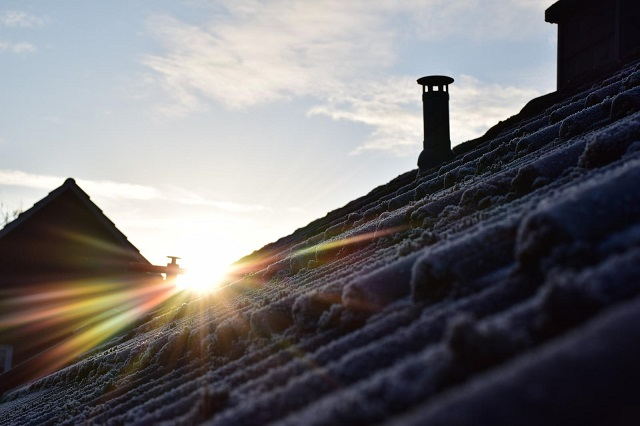
You might wonder why moss tends to grow on the roof in the first place. Moss, mold, and algae all thrive in shaded, moist environments. Asphalt shingles provide plenty of small grooves for moss spores. The spores can blow onto the roof in the wind, or birds can carry them on their feathers and deposit them on the roof when they land.
If trees or nearby buildings shade your roof, the lack of sunlight allows dampness to linger on the roof. Moss loves moisture, and without direct sunlight, any water left from recent rain or morning dew will remain wet longer than in other areas. This is the perfect environment for moss to proliferate.
In addition, leaves, pine needles, and sticks can trap moisture on the roof, encouraging moss growth. There’s also the added effect of the debris blocking you from seeing the moss, so it can mostly grow unchecked if the leaves don’t blow off (or if you don’t remove them).
Another factor can be a lack of proper ventilation in the attic. Condensation buildup in the attic doesn’t directly cause moss to grow but can cause excessive moisture on the roof. Having your professional roofer take a look at the ventilation can prevent not only moss but also ice dams, which are a common issue in a snowy climate.
The table below provides an overview of the most common reasons moss accumulates on a roof.
| Factor | Root Cause |
| Shade and moisture | Lack of sunlight and damp conditions create an ideal environment |
| Debris accumulation | Leaves, pine needles, and other debris trap moisture |
| Ventilation issues | Poor attic ventilation can cause excess moisture on the roof surface |
Why Moss Removal Matters
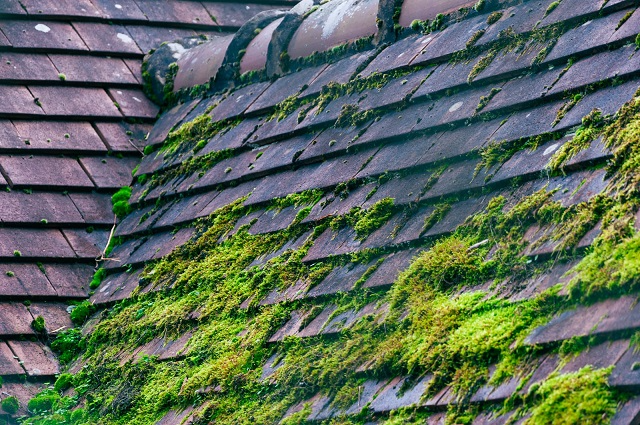
Moss might look harmless or even charming, but leaving it untreated can cause significant problems over time. Here are some reasons why moss removal is vital to keeping your roof in good condition.
- Removing moss prevents roof damage. Moss holds onto moisture, and it can also cause shingles to lift and crack, which can lead to water damage over time.
- It extends the lifespan of your roof. Without the weakened shingles caused by the moss, there’s a good chance your roof will last longer.
- It reduces the risk of mold. Moss can trap moisture on the roof, which can also lead to mold. This isn’t limited to the roof; the moisture and mold can also spread to the attic or upper level of your home.
- A moss-free roof improves curb appeal. Most people prefer a clean roof free from moss and other vegetation; it looks neater and better maintained than a roof with moss growing on it.
- Removing moss can increase energy efficiency. Your roof is meant to act as a barrier that helps prevent cold and hot air from entering your home. If it can’t reflect sunlight or it’s staying moist all of the time due to mold holding onto water, it can impact this function, which, in turn, makes your home’s heating or cooling less efficient.
If you see moss on your roof, it’s important to address it right away. Don’t let it continue to grow, as the problem won’t go away on its own in most cases.
How to Clean Moss Off a Roof
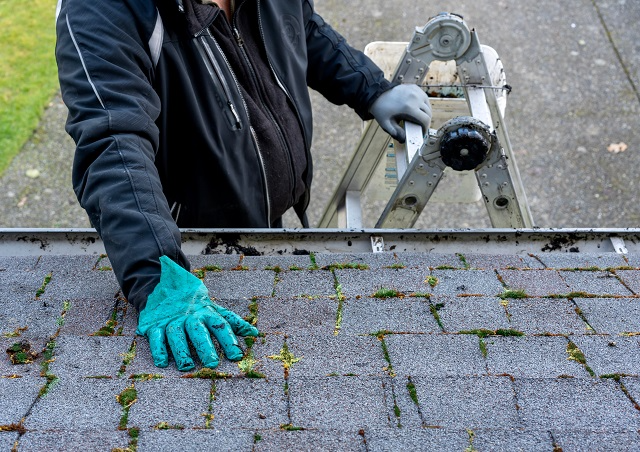
We recommend hiring a professional to clean your roof, particularly if your home is more than one story or if your roof has a steep pitch. If you want to tackle the project on your own, though, you can find the essential tools you’ll need and the steps you should take below.
What You’ll Need
- A ladder. Our top recommendation is this Louisville Fiberglass Extension Ladder, and you can find more ideas in our roundup of the best roofing ladders.
- Personal safety gear. This includes gloves, protective eyewear, and slip-resistant shoes.
- A safety harness. A safety harness can help prevent falls and serious injury.
- One or more tarps. The Boen Multi-Purpose Blue Poly Tarp is an economical choice and comes in many different sizes.
- A garden hose. You’ll use a hose with a spray nozzle to rinse moss-removal solution and loosened moss off your roof.
- Moss-removal solution. Lily Miller Moss Out is a good brand to try. You might also consider 30 Seconds Outdoor Cleaner, particularly if you’re also cleaning your siding, deck, patio, or fence.
- A soft-bristled brush or broom. Use a soft-bristled brush to gently scrub moss off your roof without damaging the roofing materials.
Steps to Take
- Get your safety gear on. Put on your gloves, eyewear, and slip-resistant shoes to keep yourself safe. Wear a safety harness, particularly if you’ll be working on a tall ladder or need to walk on the roof.
- Set up your tarps and ladder. Set up your ladder, making sure it’s in a stable location. Look at where the runoff will go, and place tarps over any plants in the way so the chemicals don’t harm them. A tarp is also a good place to toss any debris you remove from the roof.
- Sweep any debris, such as leaves or twigs, off the roof. You can also use your garden hose for this step. Don’t use a pressure washer; it can damage the shingles.
- Apply the moss-removal solution. Spray the solution onto the areas with moss. Make sure the moss is saturated, and let it sit for at least 15 minutes. It will loosen the moss and make it easier to remove.
- Rinse off the solution. Using your garden hose, start at the top and rinse the solution (and any loosened moss) off. Work down toward the bottom of the roof. Try to avoid splashing the chemical onto yourself, and be sure you’re wearing your eye protection.
- Scrub off the remaining moss. Once the roof is rinsed, you can use the brush or broom to scrub off the rest of the moss carefully. Be gentle, and sweep from top to bottom. You don’t want to push upward on the shingles, as this can damage or even dislodge them.
Safety Considerations
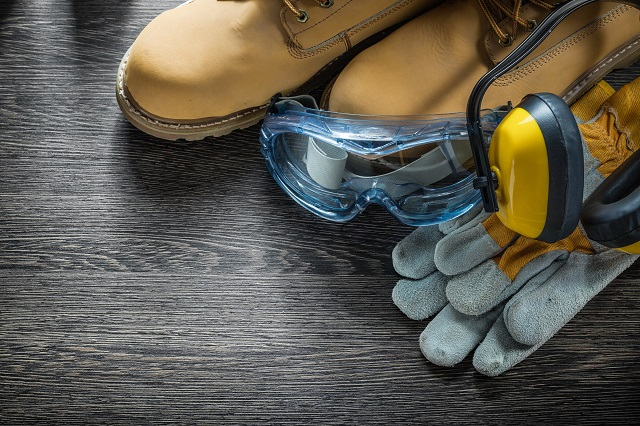
By its nature, removing moss from the roof is a somewhat risky endeavor. Only take this on yourself if you are very confident in your ability to stay safe. If you are afraid of heights, if your roof is very high, or if you’re not sure that you can navigate the ladder or walk on the roof safely, it’s always best to be safe and call in a professional.
Use personal protective gear. Sturdy gloves and slip-resistant shoes can help you prevent injury and slipping. Safety goggles will keep your eyes from coming into contact with the moss-removal chemicals and will also protect them from small debris that is rinsed or sprayed off of your roof. We like the DEWALT DPG82-11 Anti-Fog Dual Mold Safety Goggles because they’re breathable and don’t fog up.
A safety harness is another must-have if you’re working on the roof. The TRSMIMA Safety Harness is OSHA-tested and good for both construction and residential worksites.
Don’t work on your roof when you’re the only adult in the vicinity. Let an adult family member or neighbor know that you’ll be on the roof, and make sure they’re within shouting distance in case you need help.
Be aware of the weather. Don’t clean your roof when it’s rainy, windy, or snowy. Moss is slippery as it is, so you don’t want to add additional moisture to the situation if you’re going to be walking on the roof. Wind and rain can also make it dangerous to use a ladder.
Finally, be aware of the chemicals you’re using. Remember that they can harm not only your eyes and skin but also nearby plants, pets, small children, and wildlife.
Make sure children and pets stay indoors, and cover your plants with tarps. If you don’t want to use commercial chemicals, you can use a 50/50 solution of vinegar and water; this isn’t as effective, but it is safer.
Final Thoughts
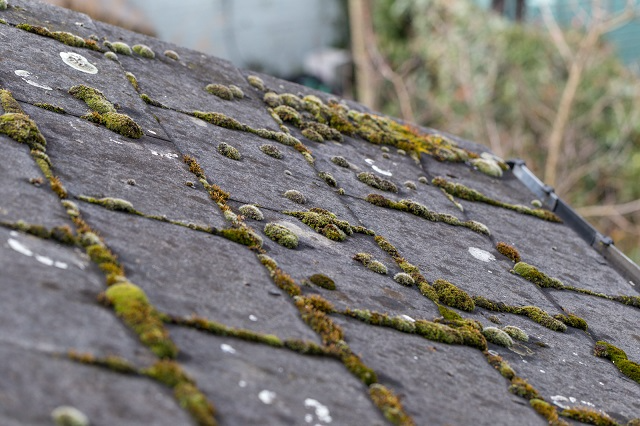
Cleaning moss off of your roof is an important part of proper home maintenance. By following the steps outlined above as well as keeping your safety in mind, you can keep your roof moss-free and in good condition.
If you aren’t sure that you can do the job safely or you simply don’t want to take it on, let the roofing experts at Ranch Roofing handle it. Our roof cleaning service ensures that your roof is moss-free and in tip-top shape without the hassle of having to do it yourself. Contact us today for a free estimate.
Frequently Asked Questions
What time of year is best to remove moss from a roof?
Removing moss from your roof can be done at any time, as long as wind, rain, snow, and ice aren’t an issue. Autumn might be the best time, though. You’ll be able to clear the fallen leaves off of your roof and give it a good visual inspection before winter comes.
Does moss on a roof mean it needs to be replaced?
Not necessarily. Moss on the roof means that the roof needs some maintenance. In some cases, the moss could be a sign of major moisture issues or damage to the roof; in that situation, the roof might need replacement. Most of the time, though, the moss removal and possibly some repairs are enough.
Will bleach kill moss on roof shingles?
Yes, a 50/50 bleach and water solution will kill moss, but bleach can discolor the asphalt if it’s not rinsed off promptly. Also, it can kill plants below as you rinse it off. We recommend a commercial moss cleaner such as the ones listed above, or if you prefer not to purchase that type of product, a vinegar and water solution.
What happens if you don’t remove moss from the roof?
Leaving moss on the roof can lead to damage such as shingle deterioration, loose or dislodged shingles, water damage, and even structural issues in your attic. Contact Ranch Roofing to address your moss issue promptly.
